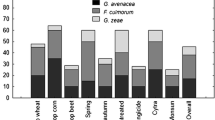Abstract
Fusarium avanacoum infected wheat and triticale heads in Poland in each season between 1985 and 1989. The average number of heads infected byF avonacaum was 26 % for wheat and 46 % for triticale out of all examined heads withFusarium head blight symptoms.Fusarium-damaged wheat grain, naturally infected byF avenaceum, contained an average of 15.9±7.7 mg moniliformin/kg, healthy looking kernels from the same heads an average of 0.42±0.19 mg moniliformin/kg. Fusarfum-damaged kernels of triticale contained an average of 3.5 mg moniliformin/kg while healthy looking kernels from the same ears contained 0.25 mg/kg.
Similar content being viewed by others
References
Rabie CJ, Marasas WFO, Thiel PG, Lubben A, and Vleggar R (1982) Moniliformin production and toxicity of differentFusarium species from Southern Africa. Appl Environ Microbiol 43:517–521
Bosch U, Mirocha CJ, Abbas HK, and di Menna M (1989) Toxicity and toxin production byFusarium isolates from New Zealand. Mycopath 108. 73–79
Chelkowski J, Zawadzki M, Zajkowski P, Logrieco A, and Bottalico A (1990) Moniliformin production byFusarium species. Mycotox Res 6:41–45
Adler A, Lew H, and Edinger W (1990) Incidence and toxigenicity ofFusarium species in cereals from Austria. (In German.) Die Bodenkultur 41:145–152
Chelkowski J (1989) Formation of mycotoxins produced by Fusaria in heads of wheat, triticale and rye. In:Fusarium-Mycotoxins, Tax-onomy and Pathogenicity. J Chelkowski (Ed), Elsevier, Amsterdam, pp 63–84
Burmeister HR, Ciegler A, and Vesonder RF (1979) Moniliformin, a metabolite ofFusarium moniliforme NRRL 6322: purification and toxicity. Appl Environ Microbiol 37:11–13
Kriek NPJ, Marasas WFO, Steyn PS, van Rensburg SJ, and Steyn M (1977) Toxicity of a moniliformin-producing strain ofFusarium moniliforme varsubglutinans isolated from maize. Food Cosmet Toxicol 15:579–587
Zhang Hong (1988) Mechanism of toxicity of moniliformin. Proceed Jap Assoc Mycotoxicol Sp. Issue No 1. pp 109–110
Sharman M, Gilbert J and Chelkowski J (1991) A survey of the occurrence of the mycotoxin moniliformin in cereal samples from sources worldwide. Food Add Cont 4:459–466
Perkowski J, Chelkowski J, Blazczak P, Snijders CHA, and Wakulinski W (1991) A study of the correlation between the amount of deoxynivalenol in grain of wheat and triticale and percentage ofFusarium damaged kernels. Mycotox Res 7A:102–114
Nelson PE, Toussoun TA, and Marasas WFO (1983)Fusarium species. An illustrated manual for identification. The Pennsylvania State University Press, University Park and London
Shepherd MJ and Gilbert J (1986) Method for the analysis in maize of theFusarium mycotoxin moniliformin employing ion-pairing extraction and high performance liquid chromatography. J Chromatogr 358:425–422
Scott PM and Lawrence GA (1987) Liquid chromatographic determination and stability of theFusarium mycotoxin moniliformin in cereal grains. J Assoc Off Anal Chem 70:850–853
Author information
Authors and Affiliations
Rights and permissions
About this article
Cite this article
Lew, H., Chelkowskl, J., Wakulinski, W. et al. Moniliformin In wheat and triticale grain. Mycotox Res 9, 66–71 (1993). https://doi.org/10.1007/BF03192236
Received:
Accepted:
Issue Date:
DOI: https://doi.org/10.1007/BF03192236




